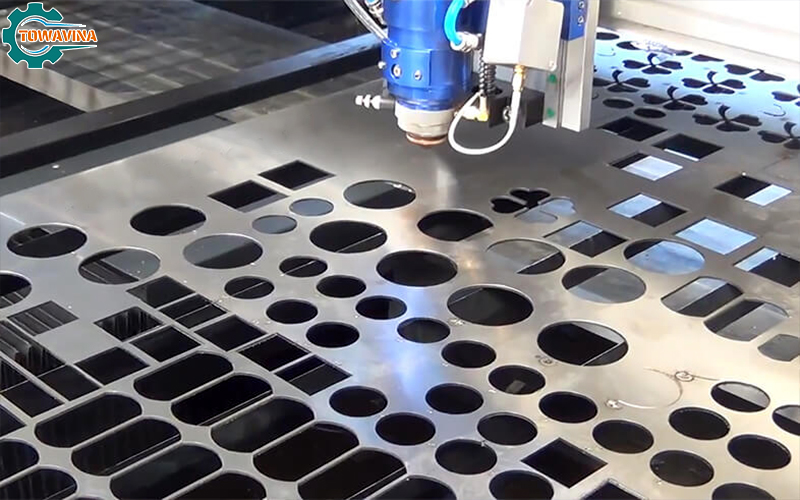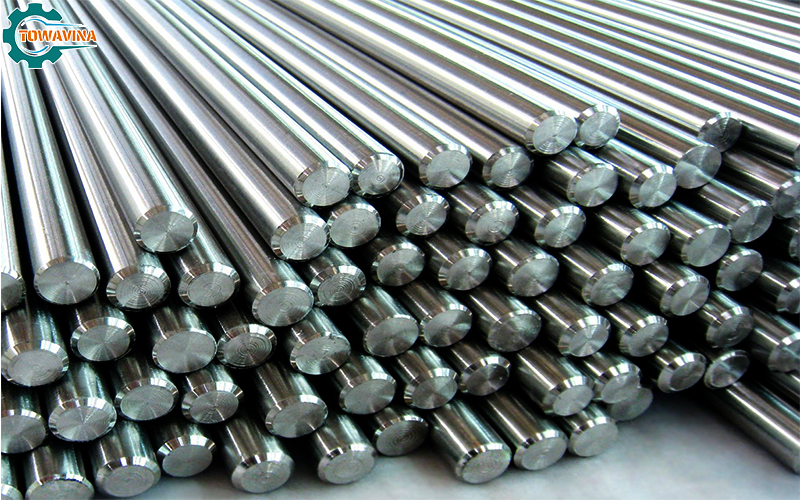Choosing materials is crucial in mechanical processing to achieve efficiency while saving costs. How do we compare the commonly used stainless steel types, 304 and the alloy 303, regarding machining capabilities and other properties? Let’s explore the differences between machining stainless steel 304 and 303 in this article with Towavina.
Understanding stainless steel 304 and 303
The most common alloy in the stainless steel group is Type 304, also known as 18-8 stainless steel. Despite its numerous advantages, Type 304 is challenging to machine due to its hardness and quick work hardening properties. To improve machinability, scientists modified Type 304 by adding sulfur or selenium, creating Type 303. The material composition of Type 303 also undergoes some changes in other properties.

Comparing machining stainless steel 304 and stainless steel 303
- Physical and Mechanical Properties
Both stainless steel Type 304 and Type 303 share common physical properties such as density, modulus of elasticity, resistivity, specific heat capacity, thermal conductivity, coefficient of thermal expansion, permeability, and annealing temperature. However, their mechanical properties have some differences. Type 303 has slightly higher tensile strength compared to Type 304, but lower yield strength and elongation.
- Chemical Properties
The primary difference in the chemical composition between Type 304 and Type 303 is the addition of sulfur in the latter. Besides sulfur, Type 303 also contains a significant amount of phosphorus. The Type 303Se variant includes selenium. However, the production of Type 303Se is currently rare. Stainless steel alloys like Type 303UX and Type 304Cu contain copper in their chemical composition. Copper helps reduce material hardness and permeability, providing corrosion resistance and enhancing the machinability of the alloy.
- Machining Capability
Compared to other materials like aluminum or low carbon steel, stainless steel is more challenging to machine. It tends to produce long chips and stringy shapes, resulting in tool edge build-up. This is due to properties such as high tensile strength, significant difference between yield strength and ultimate tensile strength, high hardness and toughness, high work hardening rate, and low thermal conductivity. Despite different properties and behaviors, stainless steel can still be machined using appropriate techniques, including higher energy consumption, lower cutting speeds, rigid tools and fixtures, the use of chip breakers or curling tools, as well as effective lubrication and cooling methods during machining.
Among numerous stainless steel alloys, some are easier to machine than others, known as free-machining alloys. Type 303 is the most common member of this group. Free-machining alloys contain additional elements like sulfur, selenium, lead, copper, aluminum, and phosphorus. These alloys generate less friction, accumulate fewer materials on cutting tools, and produce easily breakable chips during machining.
Type 303 has improved machining capabilities compared to Type 304, which cannot be considered a free-machining alloy. However, the welding capability of Type 304 is higher than that of Type 303

- Corrosion Resistance Capability
All austenitic stainless steels possess excellent corrosion resistance. Differences in the chemical composition of alloys result in varying corrosion resistance capabilities. Stainless steel Type 303 has slightly lower corrosion resistance compared to Type 304 due to the addition of sulfur and phosphorus.
Type 303 demonstrates corrosion resistance against atmospheric sources, disinfectants, organic chemicals, and dyes. They exhibit good resistance to nitric acid, moderate resistance to sulfuric acid, and weak resistance to halogen acids. To achieve optimal corrosion resistance, parts made from Type 303 stainless steel need to be cleaned and passivated after machining to remove oils, fingerprints, and any residual foreign particles like iron filings on the surface.
- Real-world Applications
We use Type 303 stainless steel for parts requiring heavy machining due to its enhanced machining capabilities. Common applications of Type 303 include machining screws, nuts, bolts, aerospace fittings, gears, bushings, electrical components, valve bodies, shafts, and valves.
Type 304 is one of the most common stainless steel types used in manufacturing kitchen equipment, food processing or liquid handling equipment, construction materials, marine equipment, chemical containers, architectural decorations, automotive components, and heat exchangers.
With high corrosion resistance and low carbon content, Type 304 stainless steel is an ideal material for medical equipment. It has no chemical impact on the body tissue and disinfecting solutions. Type 304 also has high wear resistance and is often utilized in the medical field.
When machining stainless steel, while machining capability is crucial, in highly corrosive environments and underwater applications, corrosion resistance is paramount. Type 316 exhibits the highest corrosion resistance among stainless steels. It is similar to Type 304 but with increased molybdenum content for enhanced corrosion resistance. Type 316 is commonly used in orthopedic implants and artificial heart valves.

Common Stainless Steel Machining Methods
Machining, cutting, and grinding are crucial processes to achieve shine and surface finish on stainless steel. Machining involves using suitable methods and tools for each specific type and grade of steel. Prodec grades undergo special steel refining processes to enhance machining capabilities by up to 40% compared to standard grades. To achieve good cutting quality, the right number of blades needs to be used while adhering to accurate parameters. During grinding, precise grit levels need to be used and followed through different stages to ensure a smooth surface.
In conclusion
Above are the differences between machining stainless steel 304 and stainless steel 303 for your reference. For detailed service inquiries, please contact us. Our team of consultants and technicians is dedicated to assisting you in achieving the desired product.
TOWAVINA CO.,LTD
Binh Chuan 44, Binh Chuan, Thuan An, Binh Duong
Hottline: 0979.034.634 – 0931.155.155
Mail: sales@towavina.com
Website: towavina.com



